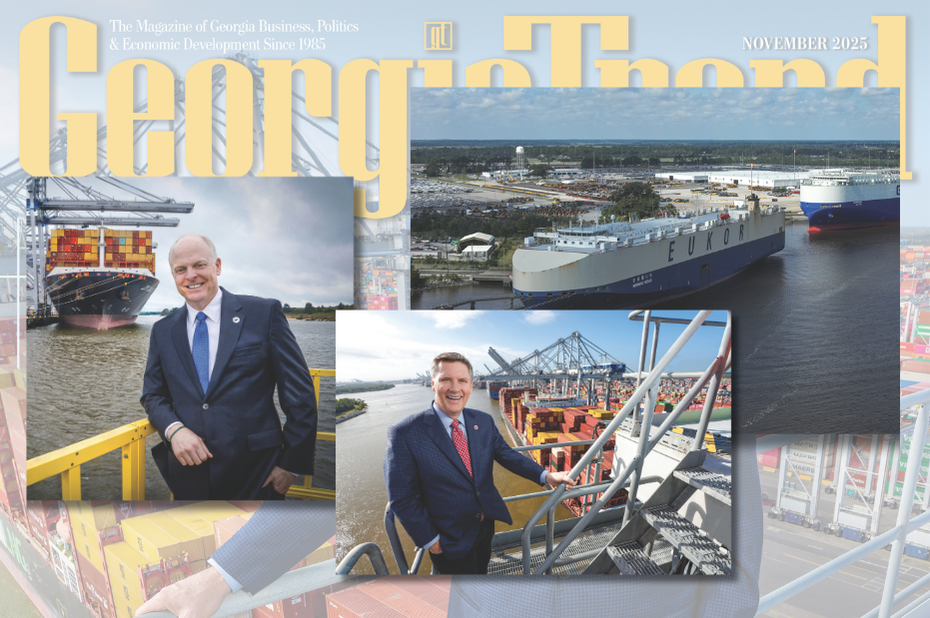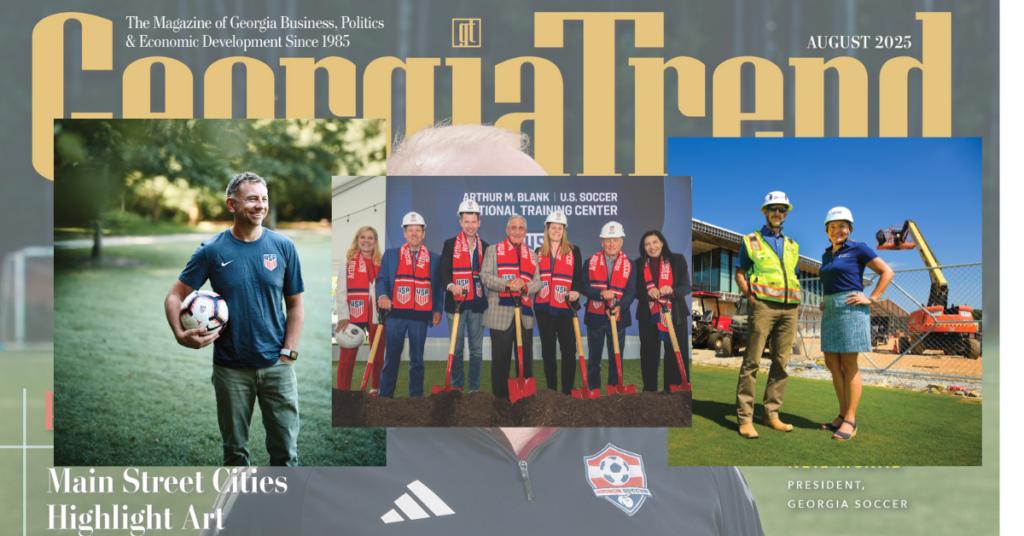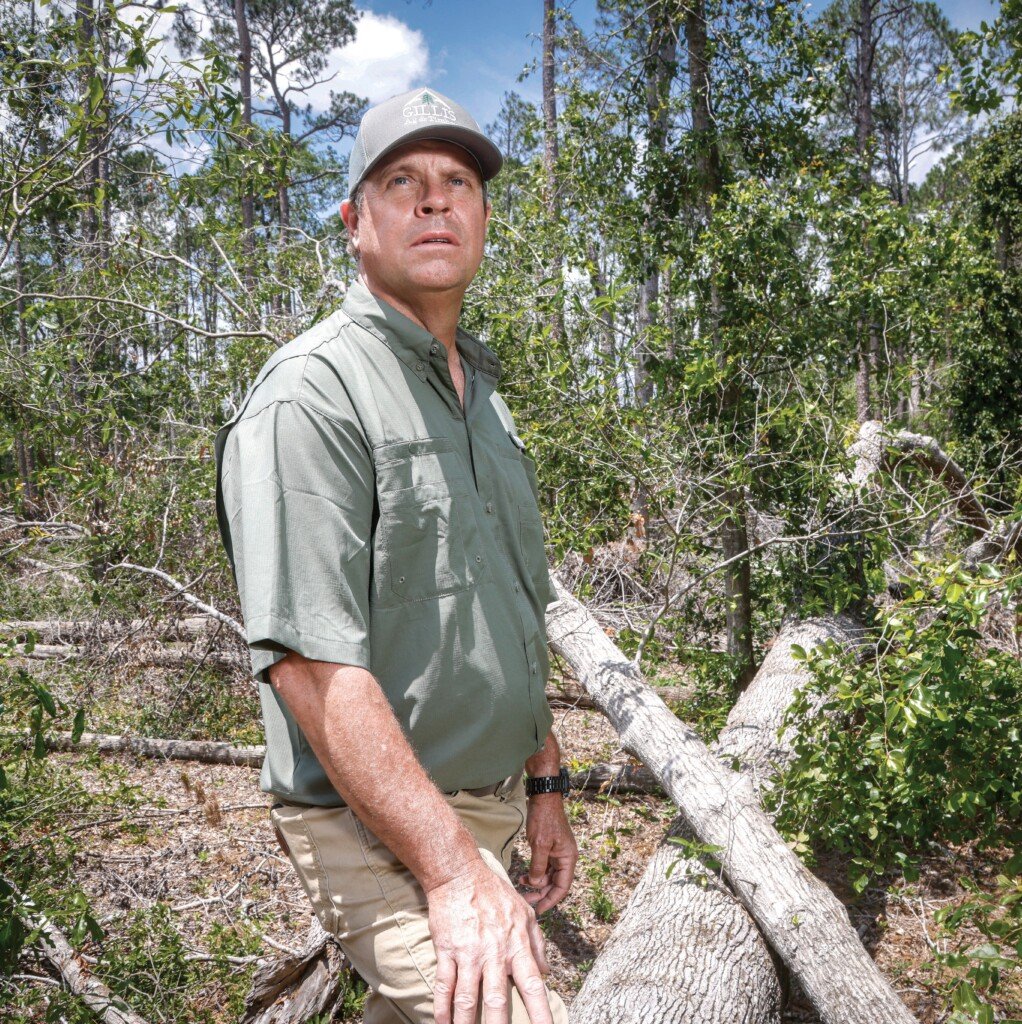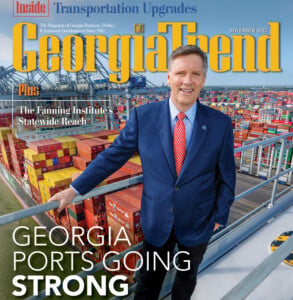Pathways and Partnerships
Public and private collaborations build a resilient statewide workforce.
For years, Georgia has touted its “Best Place to Do Business” crown, a ranking bestowed by media outlets based on metrics like the number of projects and jobs attracted, taxes and incentives, and the strength of the post-secondary education system. But according to corporate site selectors, who are both contributors to and audiences of such indices, the most important criterion is a skilled workforce. Thanks to aggressive actions and partnerships taken in the public and private sectors, workforce development in Georgia continually gets high marks.

Positive Partnership: Andrea Collins, executive director of the Thomasville-Thomas County Chamber of Commerce, and Lisa Billups, executive director of the Thomasville Community Resource Center (TCRC), collaborated on the community workforce development plan: photo David Parks.
The data speaks loudly: Georgia is a top business investment and job creation state, setting new records again during fiscal year 2023 as investments in facility expansions and new locations totaled more than $24 billion, creating 38,400 new jobs through 426 projects. Meanwhile, Georgia is experiencing record-high employment. In July, the unemployment rate stood at 3.2%, and the ratio of job listings to job seekers was approximately three to one. Several sectors, including healthcare and education, are facing severe shortages.
Legislative Leadership
In April, Gov. Brian Kemp signed multiple pieces of legislation into law designed to streamline different career pathways and fill the worker pipeline.

Leading the Way: Greg Dozier, commissioner, Technical College System of Georgia: photo Jennifer Stalcup.
Senate Bill 246 helped tackle the shortage of qualified nursing educators in the registered nursing (RN) or licensed practical nursing (LPN) pathways by providing student loan repayment for specific types of instructors. The program offers an incentive for professionals to continue to teach as an adjunct while still working.
House Bill 155 would require licensing boards to recognize most occupational licenses obtained in other states so that when professionally licensed workers move to Georgia, they can get on the job much more quickly. In May, Secretary of State Brad Raffensperger announced the creation of the GA WORKS Licensing Commission, tasked with evaluating barriers in the current licensing system and making recommendations on streamlining the process.
And Senate Bill 3 moved Georgia’s hiring practices in the direction of a national trend toward skills-based hiring, requiring the Department of Administrative Services to identify those jobs where it’s possible to modify the qualifications by removing college degree or certification requirements to attract more applicants.
A Skills-Based Future
As the state’s primary workforce development action arm, the Technical College System of Georgia (TCSG) leads from the front in skills-based hiring.
“We’re the state’s provider of certificate and two-year programs,” says Mark Peevy, chief of staff at TCSG. “We had already started assessing qualification levels and requirements where we might’ve had four-year degrees as a requirement to see if there was an opportunity to do something different. This [law] is doing that across the state and suggests that Georgia is serious about it.”
“It’s still an employee’s market, so showing an individual that your company is willing to invest in them long-term, offering a career development plan… that’s where employers are going to have to be a lot more flexible.” Karen Kirchler, Deputy Commissioner of Workforce Development, Technical College System of Georgia
The move toward skills-based hiring entails more than a different list of requirements or a new way of looking at the position.

Success Story: Kaitlin Brinson participated in an apprenticeship program to become a registered nurse while working as a firefighter/EMT: photo David Parks.
“It requires more flexibility,” says Karen Kirchler, deputy commissioner of workforce development at TCSG. “A lot of employers are attached to the way they’ve always done it in terms of searching for applicants.”
Being flexible might reveal a good candidate with transferrable skills or provide an opportunity to create an apprenticeship to move a candidate along a career pathway.
“It’s still an employee’s market, so showing an individual that your company is willing to invest in them long-term, offering a career development plan that includes them gaining more knowledge and skills over time and progressing them to more opportunities within the company if they’re inclined, that’s where employers are going to have to be a lot more flexible,” Kirchler says. “But they can see a lot of success.”
Registered apprenticeships like those offered through TCSG are demonstrably effective ways to grow the workforce, fill shortages in areas like nursing, and help people obtain more lucrative jobs. In 2018, Kaitlyn Brinson, 31, was a firefighter in Thomasville. While earning her emergency medical technician (EMT) certification, she took the prerequisite RN courses at Southern Regional Technical College. After finishing her EMT certification, she entered the RN apprenticeship program, working as a nurse extern at Archbold Medical Center in Thomasville while continuing her education.
“For me, [the program] was 100% worth it,” Brinson says. “I attribute a lot of my confidence and skill set to the apprenticeship program. I still have those relationships at Archbold Medical Center with nurses that have been there for years and years. I see them as friends and as people I can [go to with] questions if I need them.”
Encouraging the Discouraged Worker
Much of the workforce training, funding and assistance the TCSG provides is accomplished under the Workforce Innovation Opportunity Act (WIOA), federal legislation that provides job seekers with access to employment, education, training and support services. Federal WIOA funds are administered by the TCSG.

Addressing Challenges: Greg Wilson, assistant director at the Carl Vinson Institute of Government at the University of Georgia: photo Daemon Baizan.
Some funds are distributed to Georgia’s 19 designated Local Workforce Development Areas (LWDA) to pay for workforce programs and training. The TCSG acts as a conduit of grant funding, and then monitors compliance with federal regulations, minimizing the bureaucracy while maximizing the local workforce area’s effectiveness.
Last October, the TCSG received a $15 million Quality Jobs, Equity, Strategy, Training (QUEST) Disaster Recovery Grant (COVID-related funding), establishing the Untapped Workforce Initiative. The grant supported programs in Local Workforce Development Areas and are designed to serve “discouraged” workers – people who are job-age but not participating in the workforce for various reasons, anything from lack of skill to previous incarceration.

Speaking at a staff meeting: Greg Wilson, assistant director at the Carl Vinson Institute of Government at the University of Georgia: photo Daemon Baizan.
Earlier this year, another feature of WIOA, the Wagner-Peyser Program which established employment service offices nationally, transitioned from the Georgia Department of Labor (DOL) to TCSG. In the past, Georgians used the EmployGeorgia job search dashboard on the DOL website to upload a resume and find statewide job listings. In August, that website was replaced by a newly realigned job search portal – worksourcegaportal.com – combining job search and labor market information from the DOL and training and online learning resources from the technical college system. “As we look at consolidation of services around the workforce, I believe that’s going to help us [serve anyone] from the unemployed to the underemployed to someone who’s just trying to improve themselves or get back into the workforce, and [it] gives a continuity that other states don’t have. That puts us in a great position for these new jobs that are coming,” says TCSG Commissioner Greg Dozier.
A Unified Approach
“I always talk about workforce development as a team sport,” says Greg Wilson, assistant director at the Carl Vinson Institute of Government at the University of Georgia. “No one entity can do it alone. We at the University of Georgia or at the [Carl Vinson Institute of Government] can’t do it alone. But we know that in communities, it can’t just be the College and Career Academy or workforce board at the technical college solving this alone. It’s got to be all the partners working alongside the employers in their communities working to address challenges.”
In that spirit, the Carl Vinson Institute created the Georgia Workforce and Economic Resilience Center located at UGA, a “Center of Excellence” resource for all 159 counties in Georgia. Among other things, the center is engaged in events and education, offering programming for business leaders and economic developers, as well as educators and community leaders.
“As we look at consolidation of services around the workforce, I believe that’s going to help us take someone from the unemployed, to the underemployed … and gives a continuity that other states don’t have, and that puts us in a great position for these new jobs that are coming.” Greg Dozier, Commissioner, Technical College System of Georgia
“Workforce development is this critical issue for attracting jobs and investment to our state but also for supporting existing industry,” Wilson says. “The same [goes for] economic resiliency. Having a center meant having a vehicle to better meet the needs, coordinate resources and have one unified approach to how we work on these topics.”
The Institute also partnered with Georgia Power to create (and recently updated) the Georgia Workforce Planning Guide, an extensive workforce roadmap for communities interested in creating their own workforce development strategy from start to finish. The community of Vidalia-Toombs County tested the process laid out in the guide.
“They had a great job fair when COVID benefits were ending in 2021, which was a big success for them, and they had programs to engage youth and work on entrepreneurship,” says Wilson. “It helped them build a coalition of business, community and education leaders that will work together long-term to address these needs. Because the other thing you’ll hear me say about workforce is that it’s a long-term proposition with no quick fix. But we’ve seen if a community puts its mind to it and builds a strategy and implements it, they can make real change to address needs.”
Silver Lining Workforce Strategy
Workforce partnerships are springing up throughout the state. In 2018, Andrea Collins, executive director of the Thomasville-Thomas County Chamber of Commerce, heard a presentation about the impact of creating a birth-to-work pipeline. Merrill Kemp-Wilcox, then the director of outreach and engagement for the Georgia Partnership for Excellence in Education (GPEE), talked about investing in education earlier rather than later in a child’s development – and using that as the foundation for the community’s economic and workforce development strategy. Her ideas resonated with Collins. But it wasn’t until after the COVID-19 pandemic in 2022 that they could work together on it.
The timing blip provided a silver lining.

Merrill Kemp-Wilcox, consultant for the Georgia Partnership for Excellence in Education: photo contributed.
“We’ve all seen and experienced the workforce shortages [that arose during the pandemic], and for better or worse, people in all sectors are willing to think about doing things quite differently,” says Kemp-Wilcox, now a consultant with GPEE.
Collins partnered with Lisa Billups, executive director of the Thomasville Community Resource Center (TCRC). A local nonprofit, the Williams Family Foundation of Georgia, provided the $70,000 grant to fund GPEE’s involvement in developing the community workforce development plan. The three entities – the chamber, the community resource center and the foundation, invited leaders from local government, civic and community groups like the Kiwanis, Rotary and NAACP, business and industry, and the school and childcare systems to become part of the dialogue. The groups examined community data, discussed challenges and came up with five “pinch points” they wanted to address in what came to be known as The Workforce Plan.
“There were three items we knew [were problems before] but didn’t realize until it was proven with data,” Collins says. “The first was childcare. For every five kids under age five in our community, we have one childcare slot. We knew it was bad. We didn’t know it was that bad.
“The second piece is that we knew third-grade literacy is critical, and we knew we had a population in our community that couldn’t read at third-grade level. When you combine both our school systems [city-county] and look at the data, we realized that these [non-readers] are our future citizens. We knew it, but we didn’t know it. The third piece, [our] pipelines to post-secondary. We knew we had individuals who had graduated from high school and started some sort of postsecondary credential, around 40%, but they didn’t finish. Those credentials of value provide opportunities to those families.”
Addressing barriers to work such as a lack of reliable transportation, inaccessible childcare or eldercare, a lack of affordable housing or other worker issues employers typically view as “not my problem” also came up in the conversation.
In practical terms, such solutions might manifest as a company pouring resources into a well-run local daycare – assisting the experts in doing what they do best by creating more openings for employees’ children rather than reinventing the wheel and attempting to build a daycare on company grounds.
Attempting Something Big

Community Driven: Andrea Collins, executive director of the Thomasville-Thomas County Chamber of Commerce, and Lisa Billups, executive director of the Thomasville Community Resource Center (TCRC), with some young neighbors: photo David Parks.
Finally, Thomasville-Thomas County is investing in a typically ignored pinch point they hope will have systemic and generational ramifications.
“Thomasville is a wonderful place to live for some, but not all,” says Collins. “That was an eye-opener for some. That allowed us to start opening up conversations, which is the foundation for all of it, [having] conversations on sensitive topics, like racial, economic and educational equity, and to have the tools to do that.”
Community leaders trained at the J.W. Fanning Institute for Leadership Development at UGA in Reflective Structured Dialogue, a research-based framework to approach systemic change, to assist them in navigating hard conversations – particularly in the school systems, around leadership, racial inequities and lack of resources for racial minorities and cognitively challenged students.
After 18 months of living The Workforce Plan, the chamber and its partners realized there are still people in the community who have yet to learn it exists. They’ve created an elevator pitch and a one-page graphic describing the work and they continue inviting community members to join them. In 2024, they plan a community-wide conversation/celebration called “The Longest Table” to continue the workforce dialog.
“We will shut down the downtown Bricks, our brick streets, and have over 200 community members come together to build relationships and continue the conversations we’re starting to unfold,” Collins says. “We are attempting something big, and this is community driven. If the community doesn’t want it, it won’t happen.”
Change is Here
Chris Clark, president and CEO of the Georgia Chamber of Commerce, warns of a looming demographic cliff as the state enters a period of talent and population decline.

Revamping Recruitment: Chris Clark, president and CEO of the Georgia Chamber of Commerce: photo contributed.
“Several different things are happening, but primarily you have the tail end of Generation Z, one of the smallest generations,” he says. “Starting next year, the high school population will begin to decline. It will decline steadily for seven years.”
The ripple effect is seven years of decline of college graduates and workers entering the workforce. The problem is compounded by the retirement of Baby Boomers by 2030, coupled with technological advances.
“We spend a lot of time unpacking the data and talking frankly about what businesses have been doing,” says Clark. “They have paid more wages and provided more flexibility. Many are starting their own training programs and sending people to be retrained. But we also talk about how employers need to look at nontraditional pockets of potential workforce. By that, I mean men and women who have been incarcerated, refugees, [individuals] with disabilities, maybe seniors who have worked then retired but [still] want to do something. Some companies offer job sharing, where two workers share a job. They don’t pay benefits, but they pay a salary, and we still get to mentor and contribute.”
Companies need to start recruiting future employees early, preferably while they’re in high school and middle school, and support the people influencing them – their teachers.
“There’s a company in Brunswick doing externships,” Clark says. “They’re paying for substitute teachers so high school teachers can go to the company and be embedded, learn the jobs, the skills, and take that back to the classroom.”
Today’s businesses are revamping outreach and recruitment efforts, building new relationships in post-secondary education and becoming more intentional about finding the needed workers.
“You can’t hope they respond because you put up a billboard because that doesn’t work,” says Clark. “You have to connect to them, find them, seek them on their platforms.”







